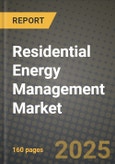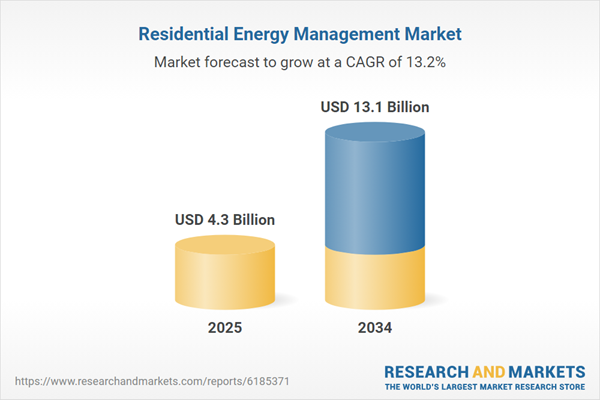The Residential Energy Management Market is rapidly expanding as households seek smarter, more efficient ways to monitor, control, and reduce energy consumption. This market includes a range of hardware and software solutions such as smart thermostats, energy monitoring systems, home automation platforms, load controllers, and integrated energy storage. Driven by growing environmental awareness, rising energy costs, and increased adoption of renewable energy technologies, homeowners are becoming active participants in energy conservation. Utility providers are also encouraging the use of residential energy management systems (REMS) through time-of-use pricing models and incentive programs. These systems offer real-time data analytics, usage alerts, and remote management features, allowing consumers to optimize energy consumption while contributing to grid stability. As electrification of homes continues and smart devices become mainstream, the market is expected to witness robust growth across both developed and emerging economies.
The residential energy management market experienced significant growth, largely driven by the widespread adoption of smart home technologies and increasing penetration of solar energy systems in homes. Governments and utility companies in North America, Europe, and parts of Asia-Pacific introduced new incentive programs for energy-efficient appliances and smart meters, boosting consumer adoption. Leading tech companies launched AI-enabled platforms capable of learning user behavior and automatically adjusting energy usage for HVAC systems, lighting, and appliances. Integration with electric vehicle (EV) charging systems also became a major trend, as households sought to optimize electricity use and take advantage of off-peak rates. Data privacy and cybersecurity emerged as central concerns, prompting vendors to strengthen encryption protocols and user controls. Interoperability among smart devices and platforms improved, making it easier for consumers to adopt plug-and-play solutions. Meanwhile, app-based dashboards allowed homeowners to track energy savings and environmental impact in real time.
The residential energy management market is expected to mature into a core component of the global smart grid ecosystem. AI and predictive analytics will play a greater role in enabling demand forecasting and personalized energy optimization strategies. With increasing adoption of rooftop solar, home batteries, and bi-directional EV charging, homeowners will become active energy producers and participants in peer-to-peer energy trading networks. Governments are expected to tighten building codes and introduce mandatory energy performance disclosures for residential properties, further pushing the demand for smart energy management systems. Integration with blockchain could facilitate secure and transparent energy transactions at the community level. Additionally, voice-controlled interfaces and sensor-based automation will enhance user convenience and system responsiveness. As sustainability goals drive decarbonization efforts globally, residential energy management solutions will be pivotal in aligning household consumption with broader energy transition targets.
Key Insights: Residential Energy Management Market
- AI-powered energy management platforms are automating consumption optimization by learning homeowner behavior and forecasting usage patterns in real time.
- Integration of REMS with rooftop solar, home batteries, and EV chargers is enabling energy self-sufficiency and grid interaction for residential users.
- Consumer demand for interoperability is driving the development of open-platform systems compatible with a wide range of smart home devices.
- Mobile and web-based energy dashboards are enhancing transparency by allowing homeowners to monitor consumption, savings, and emissions reduction in real time.
- Heightened focus on cybersecurity and data privacy is shaping new standards for secure communication and user control in REMS solutions.
- Rising residential electricity bills and the need to reduce energy waste are motivating consumers to adopt smart energy management solutions.
- Government policies, incentives, and net metering programs are encouraging the deployment of REMS, especially in homes with renewable energy systems.
- Growth of the smart home ecosystem and increased connectivity are making it easier to integrate energy management into existing home infrastructure.
- Decarbonization and climate goals are prompting utility providers and homeowners alike to invest in efficient, clean, and connected energy solutions.
- High upfront costs of advanced REMS technologies and limited consumer awareness in emerging markets continue to hinder widespread adoption, particularly among low- and middle-income households.
Residential Energy Management Market Segmentation
By Component
- Hardware
- Software
By Type
- Energy Management Platform (EMP)
- Energy Analytics
- Customer Engagement Platform (CEP)
By Application
- Power Monitoring and Control
- Load Shedding and Management
- Flexible Load Management
Key Companies Analysed
- Samsung Electronics Co. Ltd.
- Microsoft Corporation
- Tesla Inc.
- Siemens AG
- General Electric Company
- LG Electronics Inc.
- Panasonic Holdings Corporation
- Mitsubishi Electric Corporation
- Schneider Electric SE
- Honeywell International Inc.
- Toshiba Corporation
- Daikin Industries Ltd.
- Haier Smart Home
- Johnson Controls International PLC
- Eaton Corporation PLC
- Carrier Global Corporation
- Trane Technologies plc
- Enphase Energy Inc.
- SunPower Corporation
- Vivint Smart Home Inc.
- ecobee
- SmartRent
- Tado Gmbh
- Dandelion Energy
- Span.IO Inc.
- Bosch Thermotechnik GmbH
- OhmConnect
- Sunverge Energy Inc.
- The Mobility House Gmbh
- Mixergy Ltd.
Residential Energy Management Market Analytics
The report employs rigorous tools, including Porter’s Five Forces, value chain mapping, and scenario-based modeling, to assess supply-demand dynamics. Cross-sector influences from parent, derived, and substitute markets are evaluated to identify risks and opportunities. Trade and pricing analytics provide an up-to-date view of international flows, including leading exporters, importers, and regional price trends.
Macroeconomic indicators, policy frameworks such as carbon pricing and energy security strategies, and evolving consumer behavior are considered in forecasting scenarios. Recent deal flows, partnerships, and technology innovations are incorporated to assess their impact on future market performance.Residential Energy Management Market Competitive Intelligence
The competitive landscape is mapped through proprietary frameworks, profiling leading companies with details on business models, product portfolios, financial performance, and strategic initiatives. Key developments such as mergers & acquisitions, technology collaborations, investment inflows, and regional expansions are analyzed for their competitive impact. The report also identifies emerging players and innovative startups contributing to market disruption.
Regional insights highlight the most promising investment destinations, regulatory landscapes, and evolving partnerships across energy and industrial corridors.Countries Covered
- North America - Residential Energy Management market data and outlook to 2034
- United States
- Canada
- Mexico
- Europe - Residential Energy Management market data and outlook to 2034
- Germany
- United Kingdom
- France
- Italy
- Spain
- BeNeLux
- Russia
- Sweden
- Asia-Pacific - Residential Energy Management market data and outlook to 2034
- China
- Japan
- India
- South Korea
- Australia
- Indonesia
- Malaysia
- Vietnam
- Middle East and Africa - Residential Energy Management market data and outlook to 2034
- Saudi Arabia
- South Africa
- Iran
- UAE
- Egypt
- South and Central America - Residential Energy Management market data and outlook to 2034
- Brazil
- Argentina
- Chile
- Peru
Research Methodology
This study combines primary inputs from industry experts across the Residential Energy Management value chain with secondary data from associations, government publications, trade databases, and company disclosures. Proprietary modeling techniques, including data triangulation, statistical correlation, and scenario planning, are applied to deliver reliable market sizing and forecasting.Key Questions Addressed
- What is the current and forecast market size of the Residential Energy Management industry at global, regional, and country levels?
- Which types, applications, and technologies present the highest growth potential?
- How are supply chains adapting to geopolitical and economic shocks?
- What role do policy frameworks, trade flows, and sustainability targets play in shaping demand?
- Who are the leading players, and how are their strategies evolving in the face of global uncertainty?
- Which regional “hotspots” and customer segments will outpace the market, and what go-to-market and partnership models best support entry and expansion?
- Where are the most investable opportunities - across technology roadmaps, sustainability-linked innovation, and M&A - and what is the best segment to invest over the next 3-5 years?
Your Key Takeaways from the Residential Energy Management Market Report
- Global Residential Energy Management market size and growth projections (CAGR), 2024-2034
- Impact of Russia-Ukraine, Israel-Palestine, and Hamas conflicts on Residential Energy Management trade, costs, and supply chains
- Residential Energy Management market size, share, and outlook across 5 regions and 27 countries, 2023-2034
- Residential Energy Management market size, CAGR, and market share of key products, applications, and end-user verticals, 2023-2034
- Short- and long-term Residential Energy Management market trends, drivers, restraints, and opportunities
- Porter’s Five Forces analysis, technological developments, and Residential Energy Management supply chain analysis
- Residential Energy Management trade analysis, Residential Energy Management market price analysis, and Residential Energy Management supply/demand dynamics
- Profiles of 5 leading companies - overview, key strategies, financials, and products
- Latest Residential Energy Management market news and developments
Additional Support
With the purchase of this report, you will receive:- An updated PDF report and an MS Excel data workbook containing all market tables and figures for easy analysis.
- 7-day post-sale analyst support for clarifications and in-scope supplementary data, ensuring the deliverable aligns precisely with your requirements.
- Complimentary report update to incorporate the latest available data and the impact of recent market developments.
This product will be delivered within 1-3 business days.
Table of Contents
Companies Mentioned
- Samsung Electronics Co. Ltd.
- Microsoft Corporation
- Tesla Inc.
- Siemens AG
- General Electric Company
- LG Electronics Inc.
- Panasonic Holdings Corporation
- Mitsubishi Electric Corporation
- Schneider Electric SE
- Honeywell International Inc.
- Toshiba Corporation
- Daikin Industries Ltd.
- Haier Smart Home
- Johnson Controls International PLC
- Eaton Corporation PLC
- Carrier Global Corporation
- Trane Technologies PLC
- Enphase Energy Inc.
- SunPower Corporation
- Vivint Smart Home Inc.
- ecobee
- SmartRent
- Tado Gmbh
- Dandelion Energy
- Span.IO Inc.
- Bosch Thermotechnik GmbH
- OhmConnect
- Sunverge Energy Inc.
- The Mobility House Gmbh
- Mixergy Ltd.
Table Information
| Report Attribute | Details |
|---|---|
| No. of Pages | 160 |
| Published | October 2025 |
| Forecast Period | 2025 - 2034 |
| Estimated Market Value ( USD | $ 4.3 Billion |
| Forecasted Market Value ( USD | $ 13.1 Billion |
| Compound Annual Growth Rate | 13.1% |
| Regions Covered | Global |
| No. of Companies Mentioned | 30 |









